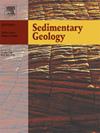Transgressive vs. forced regressive peat accumulation: Response of fluvial-apron peatland floodplains to aggradational transgression vs. forced regression
IF 2.9
2区 地球科学
Q1 GEOLOGY
引用次数: 0
Abstract
Previous work suggests the possibility that peat accumulation during relative sea-level (RSL) fall may be more common in the Quaternary and geological records than is currently commonly assumed. We investigate this further based on sequence stratigraphic analysis of successive coal-bearing cyclothems from the North China Permo-Carboniferous cratonic basin. The results show that each cyclothem changes basinward from a purely fluvial sequence to a mixed marine–nonmarine sequence. It is bounded by maximum regressive surfaces, correlative paired regional composite scour and interfluvial exposure surfaces farther landward, and correlative combined wave-ravinement and maximum regressive surfaces farther basinward. Temporally, each cyclothem transitions from a transgressive through highstand to falling-stage systems tract directly followed by the transgressive systems tract of the next cyclothem without an intervening lowstand systems tract. Depending on geomorphic conditions and characteristics of RSL rise or fall, the downstream fluvial reaches during transgression can be dominated by fluvial-fan or delta-plain channel aggradation, estuarine valley degradation, or lagoonal or fluvial-apron floodplain aggradation, or they transition from one to another. The downstream fluvial reaches during forced regression typically transition from delta plain degradation-inclusive through strandplain grade to fluvial apron aggradation-sustainable. Peat accumulation can be sustained only in fluvial-apron peatland floodplains during aggradational transgression or aggradational forced regression. Forced regressive fluvial-apron floodplain coal seams typically exhibit an overall upward decrease in mineral, ash, inertinite and sporinite contents and groundwater index, along with an increase in vitrinite content, gelification, tissue preservation and vegetation indices. Reverse trends of these properties characterize transgressive fluvial-apron floodplain coal seams.

海侵与强迫退退泥炭堆积:河流-围裙泥炭地洪泛平原对海侵与强迫退的响应
先前的研究表明,相对海平面(RSL)下降期间泥炭堆积的可能性在第四纪和地质记录中可能比目前普遍假设的更常见。通过对华北二叠-石炭系克拉通盆地连续含煤旋回的层序地层学分析,进一步探讨了这一点。结果表明,每一次旋回都使盆地向内由纯河流层序转变为海相-非海相混合层序。它由最大退积面、向陆地更远的相关成对区域复合冲刷面和河间暴露面、向盆地更远的相关波浪冲刷面和最大退积面组成。在时间上,每个旋回从海侵经过高位系统域直接过渡到下降阶段系统域,随后是下一个旋回的海侵系统域,没有低位系统域的介入。根据地貌条件和RSL上升或下降的特征,海侵期间下游河流河段可能以河流-扇或三角洲-平原河道淤积、河口河谷淤积、泻湖或河流-河滩淤积为主,或由一个过渡到另一个。强迫回归期间,下游河流河段典型地从三角洲平原退化-包容-滨滩平原等级过渡到河流围裙退化-可持续。泥炭只有在淤积海侵或淤积强迫退行过程中,才能在河缘泥炭地洪泛平原上持续积累。强迫退积河滩煤层的矿物、灰分、惯性质、孢子质含量和地下水指数总体呈上升趋势,镜质组含量、凝胶化、组织保存和植被指数呈上升趋势。这些性质的反向趋势是海侵型河围滩煤层的特征。
本文章由计算机程序翻译,如有差异,请以英文原文为准。
求助全文
约1分钟内获得全文
求助全文
来源期刊

Sedimentary Geology
地学-地质学
CiteScore
5.10
自引率
7.10%
发文量
133
审稿时长
32 days
期刊介绍:
Sedimentary Geology is a journal that rapidly publishes high quality, original research and review papers that cover all aspects of sediments and sedimentary rocks at all spatial and temporal scales. Submitted papers must make a significant contribution to the field of study and must place the research in a broad context, so that it is of interest to the diverse, international readership of the journal. Papers that are largely descriptive in nature, of limited scope or local geographical significance, or based on limited data will not be considered for publication.
 求助内容:
求助内容: 应助结果提醒方式:
应助结果提醒方式:


